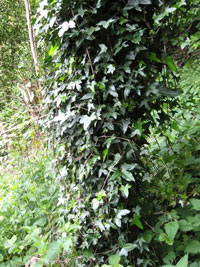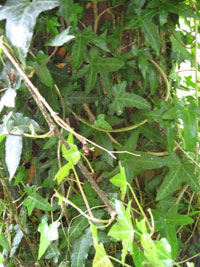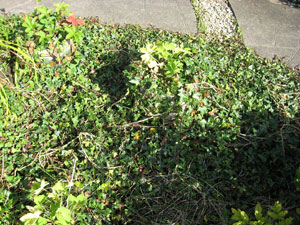Recording variation in ivy leaves
Class practical
This activity provides an opportunity to plan an investigation of the variables that might affect the growth of ivy, and a chance to review ideas about factors affecting plant growth. The detail of the relationship between leaf width, petiole length and environmental conditions is complex and it is not expected that students will produce conclusive results to support their hypotheses. It is a good example investigation to develop skills relevant to How Science Works.
Lesson organisation
If there is no ivy growing in the school grounds, it might be possible to photograph ivy growing on a tree or wall, and pick some leaves from known areas of the plant. You can then put the leaves into labelled plastic bags and use them with several groups. Alternatively, this project could suit a field course or field study week.
Apparatus and Chemicals
For each group of students:
Access to ivy leaves or ivy growing up a tree or wall
Measuring instruments according to students’ plans (Note 1)
Instruments to measure environmental factors such as light meters, moisture meters, anemometers and thermometers.
Health & Safety and Technical notes
There is some evidence that the sap from ivy leaves can be irritant when handled by sensitive individuals. Leaves and soil may carry pathogens, so take sensible hygiene precautions and encourage students to wash their hands after handling leaves or soil.
Spirit-in-glass thermometers are safer than mercury-in-glass thermometers in the case of breakage.
1 Suitable measuring instruments for ivy leaves might include: tape measures, metre rulers, shorter rulers.
2 For measuring environmental factors, temperature sensors with portable data loggers might be better than thermometers. Narrow-range pH paper will be more useful than full-range indicator paper.
3 Ivy has two forms of growth: vegetative stems with normal (usually five-pointed) leaves, and flowering stems with ovate leaves. Make sure you are comparing vegetative leaves in different conditions, and not confusing leaves on flowering stems with 'sun' leaves.
Procedure
SAFETY: Handle leaves as little as possible; wash hands before leaving the laboratory, and certainly before eating.
Preparation
a Preliminary investigations should identify general patterns in the growth of ivy leaves.
Investigation
b Students will need to make observations and measurements of environmental factors (such as light intensity, humidity, wind speed and temperature). Discuss whether readings taken at one time on one day give a meaningful measure for the environmental conditions. Repeat at intervals over a week or longer if possible, or pool the results from several groups or from year to year.
c Each group should collect data from about 50 leaves from different parts of the same plant. Differences in growth should be due to differences in the environment, not to heredity.
Teaching notes
Although ivy is common, there are several different species present in our local environment – especially if you include unusual horticultural varieties. It is important that all the leaves compared in any one investigation come from the same variety of ivy and preferably the same plant.
Factors which might affect the growth of leaves include: brightness of sunlight, moisture, temperature, degree of shelter from wind, moisture content of soil, nutrients in the soil, distance along the stem from roots to the leaf, height above the ground, and whether the leaves are growing on a stem attached to a wall or on an unsupported stem.
Plants will grow better in damp, light conditions (where they are not shaken about too much by the wind). ‘Better’ might not simply be a measure of the size of individual leaves – a plant could make a few large leaves or many small leaves if it is growing quickly and well. Leaves growing closer together (and close to the supporting structure) will lose less water. Larger leaves have a greater surface area to absorb light.
Student questions might include:
- Do ivy leaves grow bigger in sunny or shady places?
- Do leaves near the ground grow bigger than leaves higher up a tree or wall?
Presentation of results will depend on exactly what question the students are trying to answer. Frequency diagrams are useful when there is big range in the data, as they may show more clearly the difference between two sets of data.
Sample results of leaf widths from 35 leaves from one ivy plant are given in the attached ![]() Sample results of leaf widths (17 KB).
Sample results of leaf widths (17 KB).
The raw data are repeated in a long list on sheet 2 of the spreadsheet. This is easier to sort, and show students how to develop a frequency diagram.
A frequency analysis of these results gives this table of numbers; sheet 3 of the spreadsheet has a graph of these numbers.
A further collection of data shows the measurements of leaf width and petiole length for three samples of ivy leaves from a garden. See ![]() Measurements of leaf width and petiole length (25 KB).
Measurements of leaf width and petiole length (25 KB).
The ‘Light’ and ‘Dark’ leaves were collected on either side of a tall tree stump – ‘Light’ being the south-facing side and ‘Dark’ being the north-facing side of the stump. See these photographs for more information.
 |
 |
 |
 The ‘Horizontal’ set were growing on a (nearly) flat patch of ground elsewhere in the same garden – see photo on the right.
The ‘Horizontal’ set were growing on a (nearly) flat patch of ground elsewhere in the same garden – see photo on the right.
Initial analysis of these leaves suggests that there is little variation wherever ivy grows! Statistical tests for significance and more sophisticated data-handling techniques may reveal differences. Notes on such data analysis are in preparation and will be linked here when available. Perhaps the form of leaves depends more on species.
Health & Safety checked, September 2009
Downloads
Download the student sheet ![]() Recording variation in ivy leaves (0.8 KB) with questions and answers.
Recording variation in ivy leaves (0.8 KB) with questions and answers.
Download the ![]() Excel document - Sample results of leaf widths (17 KB).
Excel document - Sample results of leaf widths (17 KB).
Download the data ![]() Measurements of leaf width and petiole length (25 KB).
Measurements of leaf width and petiole length (25 KB).


